Ice amongst the rainforest

Big Mountain skier Janina Kuzma invited fellow suffer-fest addicts Anna ‘Banana’ Smoothy, Ayako Kuroda and Ben Johns to undertake an east to west winter traverse of NZ’s southern Alps. Aus Geo ADVENTURE photographer, Mark ‘Watto’ Watson, joined filmer Ross Mackay and mountain-man Mike Stewart to document the trip, but things rarely go to plan in the mountains. Cabin fever, blisters, illness, pacific storms and a forced night-time ascent of Murchison Head Wall stood in the way. With a treacherous descent through Fox Glacier Icefall, the team had to come to terms with the reality their objective might not be possible.
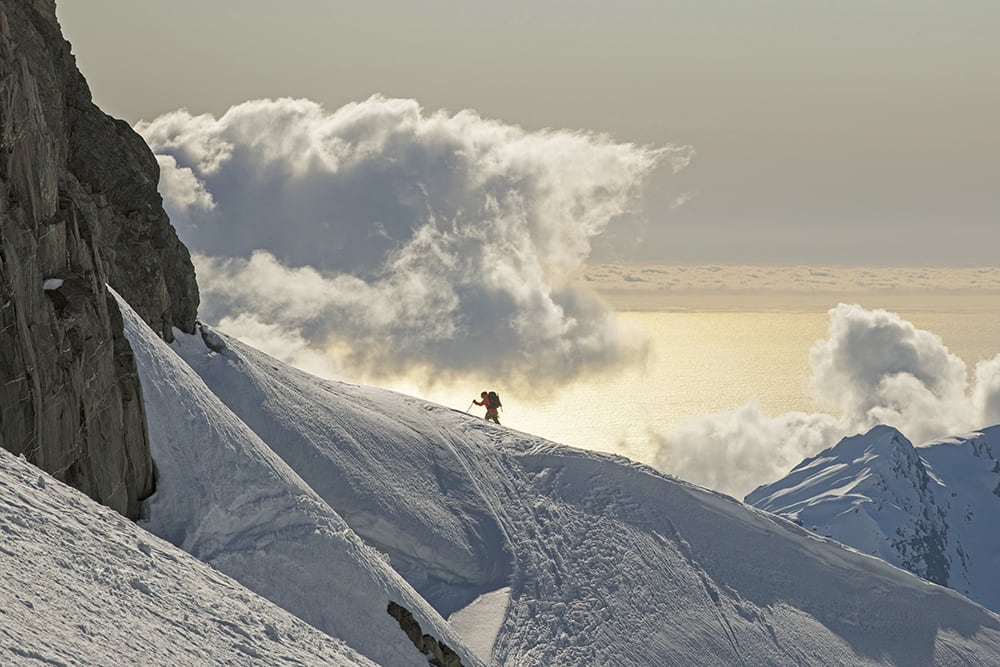
Sweating and exhausted I peer through a fading head-torch beam and discern a hunched figure at a standstill in my path. Kicking slowly closer, I recognise the green jacket and heavily loaded pack of Janina Kuzma. The former Olympic skier turned The North Face athlete is leaning on her poles.
I immediately worry. Janina doesn’t stop to catch breath; she doesn’t know how to go slow. ‘G’ as she’s known to mates, is strong as an ox. Something’s wrong!
I catch just enough breath to pant, “G! What’s going on?” But the face that turns to me is not the usual grin of the woman I know. It is somebody else, paler with glazed eyes; a face of pure exhaustion.
“I can’t put my ski crampons on Watto,” she stammers. “I’m too rooted.”
I stare blankly until my fatigued mind registers what she is telling me. Emotion begins to return to my weary brain. First, it’s a smirk, then a grin, and eventually a chuckle. I know her world of hurt all too well, when everything becomes just too hard, too steep, too big, too cold. But I never thought I’d see G show a hint of fragility. I always thought she was impervious to such a state of emotion.
G stares back at me and I realise too late I will suffer the consequences of my impromptu chuckle somewhere down the line. We both know she’s a 9/10 in the mountains and I hover at a measly five, maybe six on a good day. The only reason I’m able to laugh is because I can see the silhouette of Kelman Hut, the finish line for today’s epic race, less than 100m ahead.
As I help with her crampons, cloud roll over Mt Elie de Beaumont and the wind intensifies, tell-tale signs of the impending Pacific storm we have been racing the last 12 hours to beat. We skin the last hundred metres to Kelman Hut in single file, as the storm hits in earnest.

The fridge on the ridge
By the time we close the doors to Kelman Hut and shed our packs, harnesses and boots, snow is swirling sideways and upwards, propelled by the roaring winds from the valleys below. Mother nature screams and howls, and tears at New Zealand’s Southern Alps, seemingly trying to rip all foreign matter, including us, from the flanks of the exposed ridge on which we now lie.
I’m grateful for the industrial girth metal cables I notice ominously bolting the shelter to the surrounding rock and ice, but throughout the night I lay awake while hurricane-force winds roar up the valley like a jet engine and smash into our rickety abode, shaking it to its foundations. My mind subconsciously regurgitates a historic news article about a severe storm that tore Three Johns Hut from Barron Saddle above the Mueller Glacier, killing all inside. I lie wide-eyed in the dark until the roar abates and eventually fall asleep dreaming of the Wizard of Oz.
Stumbling down from the loft ladder in the morning I’m relieved to find the hut in one piece and a pot of freshly brewed coffee on the stove. Our eastern flank teeters on the edge of the near-sheer cliffs of the Murchison Valley and so I glance out the window hoping to glimpse the heavily crevassed Murchison Headwall we’d boot-packed the previous evening. I’m partially glad we ascended the avalanche-prone ramp in the dark – you can’t be afraid of what you can’t see right? But outside all I see is white.
Sudden movement catches the corner of my eye and I note Japanese free-skier Ayako Kuroda and local Wanaka steep-skiing charger Anna Smoothy shovelling two feet of snow from the doorway of our hut aptly named ‘The fridge on the ridge’. They re-enter from the white-out with frozen hair and frozen digits.
“We won’t be going anywhere today,” Ayako confirms.
“Bugger!” I reply, but I’m secretly relieved. I pour some coffee, climb back inside my sleeping bag and take stock of the previous day’s marathon.
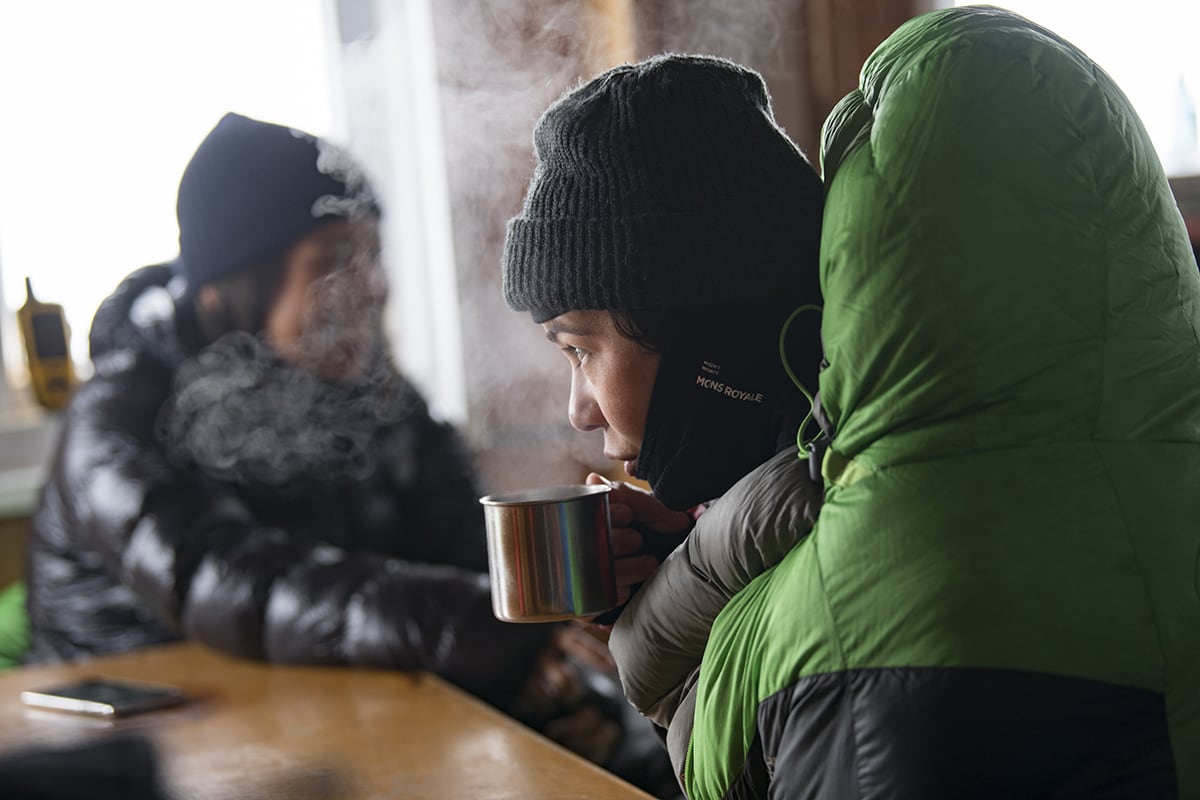
Getting here
We’d begun in the Liebig Range, where coincidentally, I first met G on a ski-mountaineering mission years ago when we’d been forced to evacuate the mountains on foot, racing a storm. Eight years later we are again racing a storm in the Liebig, this time bearing into the alpine.
Our modernised plan involved initially traversing the Liebig to descend into the lower Murchison valley where we would bivouac below the snowline prior to ascending the Murchison Glacier to the Aida Glacier. Here we would ski and photograph Mt Sydney King, Mt Acland and Mt Phyllis before camping on the glacial flats, eventually making our way to the shelter of Kelman Hut on day three.
But only this morning, sitting exposed in the roaring forties atop Mt Hutton Ridge, with the largest storm of the season bearing down on us, we found ourselves condensing three days into a single-day sprint to Kelman Hut.
It didn’t take long for me, as the only split-boarder, to begin cursing every long traverse we encountered on our descent to the Murchison, but I soon got my own back. The boulder field of the moraine delivered hours of punishing rock hopping: a soft-booted split-boarder’s paradise as opposed to the hard-boot nightmare suffered in ski touring boots.
Ayako was copping a battering. Her feet were swollen, cramping and eventually blistering to the point of considering a humiliating day-one evacuation, however a Leatherman, painkillers, copious strapping tape and a never-say-die attitude got us back to the frozen ground of the snowline, and soon we were skinning north, albeit three hours behind schedule.
From the map, the Murchison looked like a pleasant ascent up a gradual incline, but on deadline it rapidly became a quad-burning sweat-fest. We moved at a reasonable pace having ditched our bivy bags in favour of light-weight travel, but as we passed our bivouac coordinates, the reality of a three-day storm bearing down on us has us wondering whether we’d made the right call.
The Aida glacier tributary offered a glimpse into a secluded nirvana but we were forced to deem the playground off limits and instead veered westward toward the neve of the Murchison Glacier.
With the sun already sinking behind the peaks of the Multe Brun Range, we came to a blunt and despondent realisation that if we didn’t make Kelman Hut, we’d have to ration food and dig a snow cave ahead of the storm.
We hid behind a mini-bus-sized fallen serac to hastily warm and scoff freeze-dried meals, and a collective decision was made to push on and try to beat the weather. With renewed vigour, down jackets were donned, shell-layers zipped and we forged ahead in the dark toward the Murchison Headwall.
Using what little energy remained from a mammoth day, Mike kicked toeholds up the steep headwall trying to avoid the barely visible crevasses. We followed one by one, heads down, single file and in slow motion until eventually the incline eased.
Reaching the top, a communal sigh of relief was exhaled, and we limped into the ‘Fridge on the Ridge’, bodies shattered but spirits unbroken.
It would be two more days before we would see the sun again.
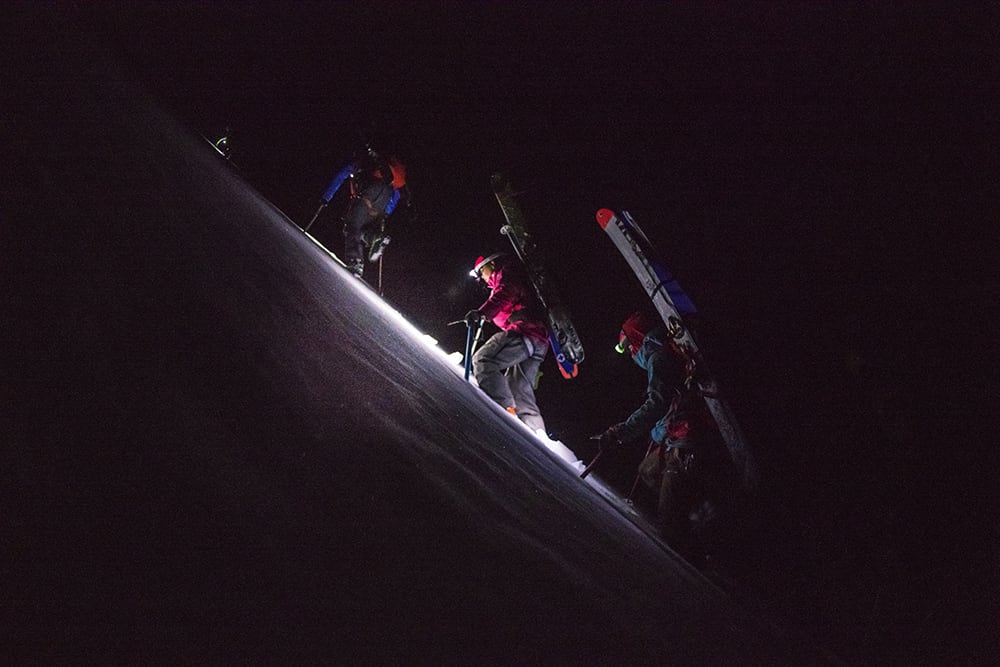
The Westlands
The Darwin Icefall on the Tasman Glacier is a sight to behold. The surreal realm of blue ice caverns, ice grottos, caves and seracs as tall as multi-story buildings deliver such scale and majesty that our insignificance in this world is magnified tenfold.
Having left Kelman Hut in a thick fog before sunrise, our first glimpse of this majestic playground comes rather abruptly when the sun pierces the mist to deliver a blue sky.
Ben, Anna, Janina and Ayako waste no time getting up close with the majestic ice formations and their grins reflect a possibility of days, skiing the icefall and nearby canyonlands. Our distant objective, however, is the West Coast, and between us and the Westlands lies the tallest mountain range in New Zealand – and the infamous Rudolf Glacier.
Two scribbled observations in my pre-trip notebook warn: a) “The Rudolf is expert ski mountaineering terrain suitable only for strong skiers with mountaineering equipment and experience.”; b) “Stay to the middle of the glacier to avoid avalanches and rock fall before climbing the steep couloirs on the south of the Rudolf icefall to Graham Saddle.”
I admit my personal Watto rating of 6/10 forces me to question how I might fare at this crux point, and so it is with trepidation I turn the De La Beche Corner where the Rudolph meets the Tasman and begin a long and arduous climb.
Ben, Anna, Janina and Ayako team up to break trail while Mike, Ross and I veer off on occasion to search for picturesque vantage points in a bid to document the journey. Five hours later, our photo and cine intentions are placed on the backburner, replaced with a bid to summit Graham Saddle in good time.
It is climbing the Rudolph where the trio of girls display strength and stamina that has elevated them to elite competition and beyond, and why they not only raised their hands for this arduous ski traverse but instigated it. Having travelled this route previously, Ben is at the pointy end, but there’s no waiting for the girls; they nip at his heels.
I ponder how fortunate I am to share this adventure with such high-calibre athletes of both sexes. In a world where the celebration of individual gender achievement can inadvertently drive wedges where they shouldn’t exist, here in the mountains we are all humbled equally. The mountains don’t care about gender, age, nor race… you either have the personal strength and aptitude to coexist with this harsh environment, or you don’t. It is a nice simplicity and a change from the divisive world we seem to have created outside of this alpine haven.
Summiting Graham Saddle proves the vast experience of those I am surrounded by when we transition from skins to skis (or in my case, split-board) quickly, and the forward party drops into the Chamberlin Snowfield, carving deep sweeping lines en route to Centennial Hut.
We make our refuge in good time and are rewarded with views of a shimmering Tasman Sea, while a spectacular sunset transforms our alpine world into a sea of golden ice crystals.
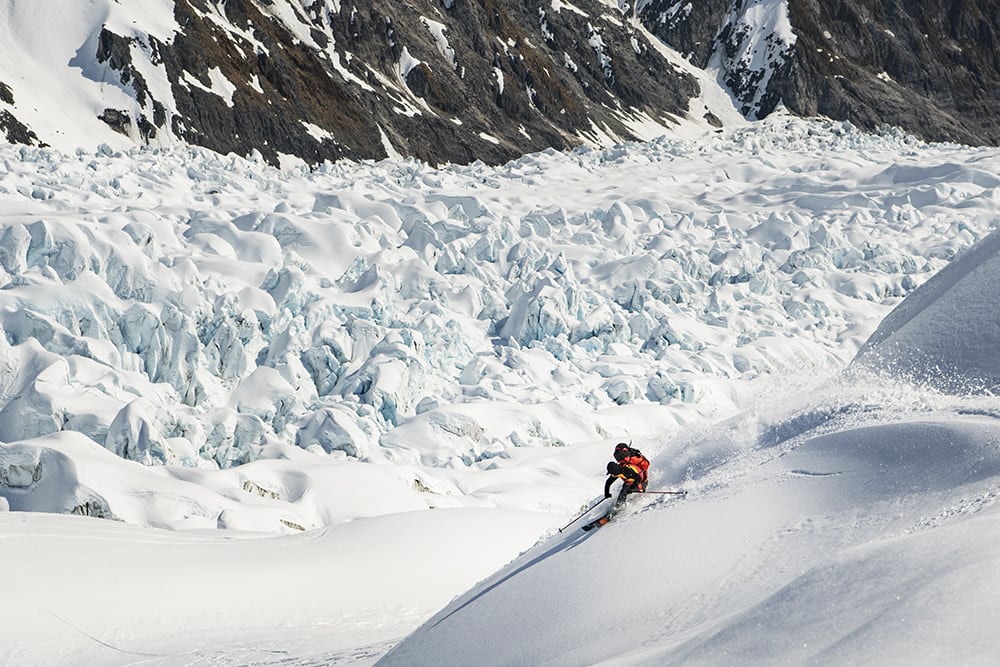
Decision Time
Nestled inside Centennial Hut we again play weatherman as another low-pressure system builds off the West Coast. A sole day of guaranteed visibility forces a decision.
First prize is to ski the upper neve of the Fox Glacier using Pioneer Hut as a base, but if the oncoming storm strengthens the extra day skiing might jeopardise our primary goal of traversing the entire east-west route. This leaves us with two escape routes: a descent of either the Franz Joseph or the Fox Glacier toward the West Coast.
With limited intel on the condition of the Franz Joseph, our plan to ski as low as possible to navigate the icefall to the terminus on foot is risky. We might find the icefall unpassable, forcing a retrace to high ground for a heli-rescue. We are left with one choice: The Fox. We all pray the Fox Glacier icefall offers a negotiable route out.
The Fox
I look on in nervousness as Anna-Banana, as I’ve come to know her, expertly navigates the bergschrunds of Explorer Glacier and the upper Fox Glacier. Anna is now in complete contrast to the laid-back radiologist I met in Wanaka.
Her freeride world-qualifying results should have been a giveaway, or maybe the fact her brother is one of the biggest hitting freeride world tour chargers on the planet. Whatever the case, I am again put in my place as I tentatively pick my way around the gaping crevasses the girls carve through at speed.
Below the bergschrunds, we happen across the best snow of the tour. I snap off photos of the team carving steep spring corn faces with an imposing Fox Glacier dominating the backdrop. Little do we know this is the last skiing we will do.
Nearly 18 hours after these last turns are had we find ourselves down-climbing near impenetrable heath, having overnighted in Chancellor Hut. The goat-track we’re on is occasionally severed by avalanche debris and rockslides. The going is slow and teeming rain does not help progress, nor does the fact that pack-bound skis catch on every branch, root or rock within arm length, but we’re all in the same miserable boat and to top it off Ayako is now ill.
Eventually our mud-stained crew find ourselves confronted with a frozen world again. But this time a 300m-deep warzone of broken and upheaved ice. Starting high in the Southern Alps and falling 2600m over its 13km length, the Fox Glacier (Te Moeka o Tuawe) is a powerful sight to behold, especially up close. Our expedition goal, to negotiate the eastern flanks of the Southern Alps to the temperate rainforest at the Fox terminal under human-powered steam is ambitious; the glacier has retreated notably in the past decade.
We swap skis for crampons and kick steps into the heavily crevassed ice. Black holes and cracks fall away at our feet to unknown depths and we move at snail’s pace, ice axe in one hand, ski pole in the other. Ten minutes in, Ayako doubles over and vomits. The accumulation of arduous days, an all or nothing diet, dehydration and the intensity of our penultimate challenge has reached tipping point for the Japanese skier.

There’s no way back, so Ayako ties into a safety line and pushes toward the distant whirring blades of the commercial heli-tours we now see operating on the glacier below. An hour later she is flown to hospital, all within sight of our end goal.
With gritted determination our remaining team re-don packs and doggedly push toward the finish line. We negotiate ‘the bowling alley’ of the Fox Moraine as swiftly as is safe to avoid being in the firing line of the car-sized boulders that crash down from the unstable slopes above.
Filthy, bruised, bloody and muddy, we eventually reach a well-worn path, then a fence, and then a tourist-filled car park. It dawns on our dishevelled crew that we have reached our goal just as news filters through that Ayako is fine.
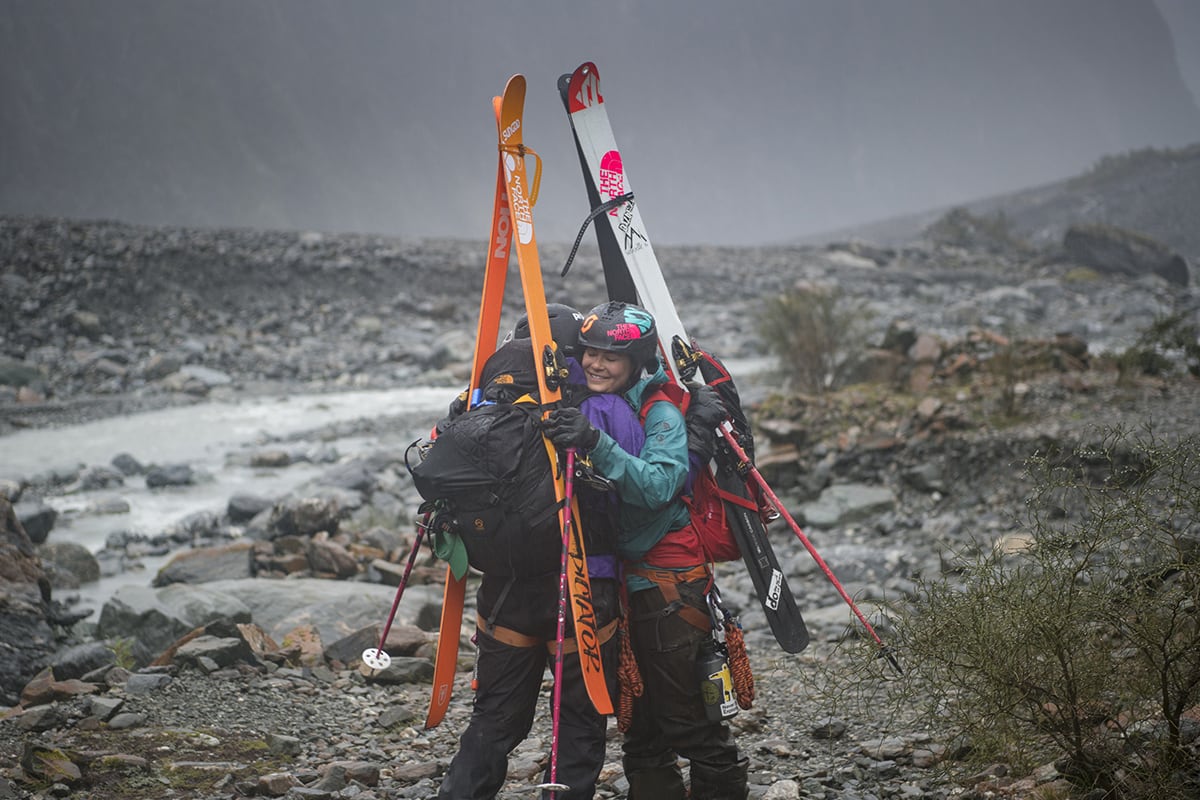
Embracing amongst a sea of friends, and strangers, we glance back toward the retreating glacier and realise global warming might soon render this epic traverse unachievable. We are glad to have achieved our goal but saddened we may be one of the last teams to have an opportunity to experience the ice amongst the rainforest.




